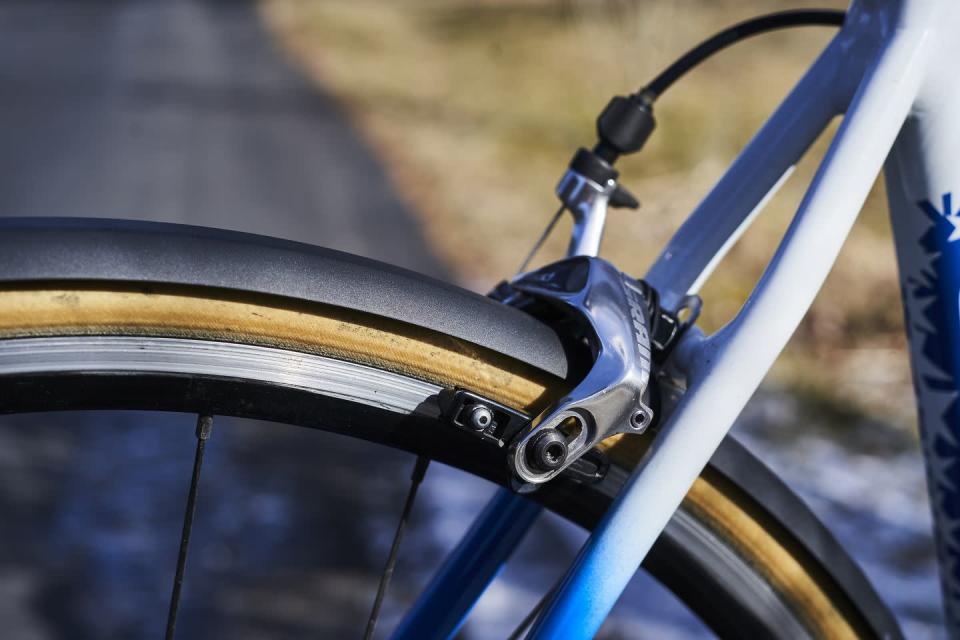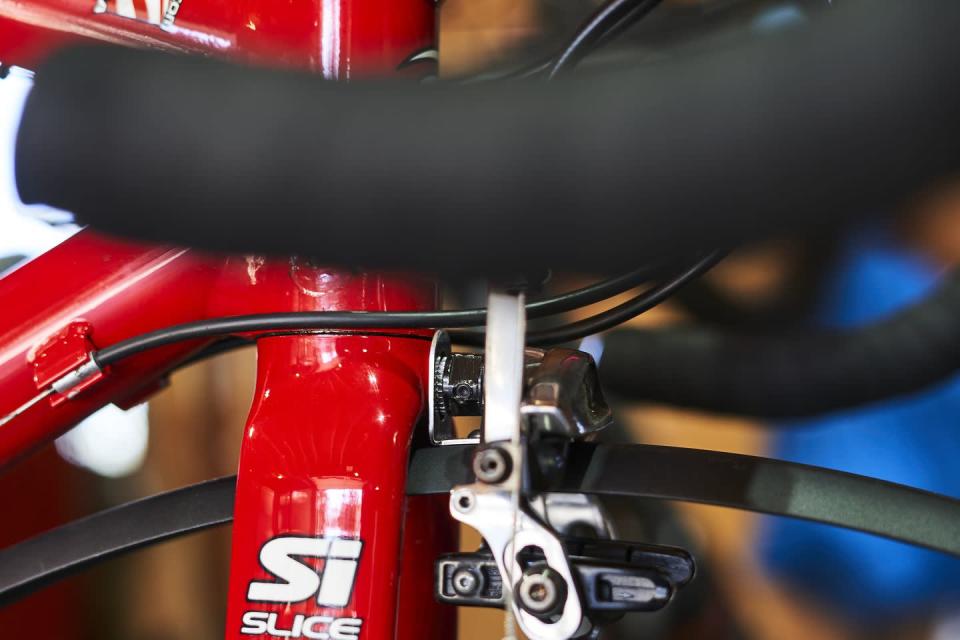[ad_1]

“Hearst Magazines and Yahoo may earn commission or revenue on some items through the links below.”
Whether you frequently ride in rainy, wintery weather or not, the humble bike fender can upgrade your ride experience, possibly more than you’d expect.
Even if you never plan on riding in the rain, water often remains on the road or trail after the clouds have cleared, posing a problem for fair-weather riders, too. If you often join group rides, a rear fender is a great investment because it will save your bottom from getting soaked and will prevent anyone who gets on your wheel from getting sprayed in the face. Fenders also protect your bike from grit and grime, which means less wear and tear on your drivetrain, brakes, and cables in the long run. Plus, a cleaner bike is good news for people who store them indoors; you won’t be dragging in as much muck with you.
There are tons of fender and mudguard options on the market. Below, we cover how to both spec, choose, and install the best fenders for your bike.
Join Bicycling now for the latest advice and tips!
Types of Fender Attachments
Bolt-On

If your bike has sufficient clearance and a seatstay bridge or a drilled fork crown (where a bolt can attach to it), this is the most durable, most secure, and cleanest-looking option.
Quick Release

If your bike doesn’t have bosses (many modern road bikes don’t) or clearance for mounting fenders, there are still options for you. Many brands offer strap-on fenders. These often come with velcro straps or clips to attach to your seatpost, seat tube, seatstays, or fork.
Saddle-Mounted

The most minimalist style of the bunch, this basic rear mudguard fits right under your saddle between the rails and works to protect your backside from the worst of it. While it doesn’t do much more than that, it’s quick and easy to install and remove.
Zip Tie

Also pretty minimal in design and easy to install, this style of mudguard is popular on mountain bikes. These front mudguards are fairly universal in design and will fit most mountain bikes. Rear zip tie mudguards vary more in design though, and compatibility will largely depend on your frame, especially for full suspension bikes.
Choosing the Right Size
With all the variations in frame design and sizing available, fenders—especially the traditional, bolt-on style—are not one-size-fits-all, so you’ll need to measure your bike and select a set that will work for your bike specifically. There are a few important measurements to consider when fitting your bike for fenders: tire radius, tire width, and frame clearance.
Tire Radius
Check the side of the tire for this. Many bikes—such as road, gravel, touring, commuter, fitness, and fixed gear—use either 650b or 700c to denote the tire radius size. Meanwhile, mountain bikes use the following tire radius sizes: 26 inch, 27.5 inch, or 29 inch.
Tire Width
Check your tire width (which is printed on the side of your tire), and choose fenders at least 8mm wider than the tire. For example, if you’re running a 42mm tire, choose fenders that are at least 50mm wide. This will help prevent rubbing on the tire and offers enough space for small rocks and other debris to roll through without getting stuck between the fender and tire.
Frame Clearance

Lastly, you need to make sure you have enough space to fit a fender between the tires and the frame. From the get-go, you ideally need 20 to 30 millimeters of space between the tire and bridges and between the tire and fork crown to fit most traditional fenders. You should make sure the front fender is narrow enough to fit between your fork and/or brake caliper (if you have rim brakes), and that the rear fender can fit between the seatstays and/or caliper.
Measure between the seatstays or inside the fork crown and in between the brake calipers when you apply them to determine if your frame will allow a wide enough fender for the tires you’re running. Depending on the fenders and your bike setup, it can sometimes be necessary to switch to narrower tires.

As far as how far the fenders wrap around the tire, that’s more of a personal preference. But generally speaking, the longer the fender, the better protection it will offer you, your bike, and your buddies. For maximum coverage, look at fenders that come with or have the option to add mudflaps. These extend further down around the tire than fenders do. A mudflap in the front will keep your feet drier and protect your bottom bracket, while a rear mudflap is mostly just a bonus to any riders behind you.

How to Install a Fender
It’s important to fit and mount your fenders correctly in order to avoid them rubbing, rattling, breaking, or—worst case scenario—catching on your front tire and sending you over the bars (OTB). Installation instructions will vary by fender type and brand, and it’s always best to follow the manufacturer’s instructions. Traditional, bolt-on fenders require a little more work to install, so we’ve outlined some basic instructions below.
Front Fender

-
Remove the wheel you will be installing the fender over.
-
Starting with the front wheel, disconnect the brake caliper and remove it from the fork crown, screw the L-bracket mounting tab into the hole you just took the brake caliper from (just tightening loosely), and attach the fender to the tab.
-
Reattach the wheel, and make sure the fender is aligned straight and equidistant from the tire all the way around.
-
Tighten down the fender on the mounting tab, and then reattach the brake caliper.
-
Attach the stabilizer poles to the fork or eyelets using manufacturer instructions and hardware.
-
Screw everything in halfway at first, in order to give yourself enough wiggle room to adjust the stabilizer length and prevent the fender from rubbing on the tire.
-
Once it’s adjusted, screw everything down tight.
Rear Fender

-
To repeat the process for the back fender, you don’t need to remove your brake caliper since the rear ones are often designed to fasten to the seatstay bridge.
-
Remove the wheel and attach the L-bracket mounting tab to the seatstay bridge.
-
Some rear fenders even extend as far down as, and require attaching to, the chainstay bridge.
-
Align everything first, then tighten the bolts and struts.
Troubleshooting Fit
There are lots of other nuts, bolts, and tricks available to get your fenders adjusted just right, depending on the problem you’re running into. If your bike doesn’t have eyelets, you have a few options for attaching struts. Axiom and Velo Orange make eyeleted tabs that slide right onto your quick release skewer and rotate to any angle around the axle for your best fit.
If your bike has thru-axles, a suspension fork, or if you’d simply rather attach the struts to your frame, consider wrapping flexible, rubber-lined p-clamps around your fork blades and chainstays.

Also, don’t be afraid to bend your struts around the brake calipers to get the fit you need, or to experiment with spacers and extra nuts or bolts to get everything lined up correctly. If your frame doesn’t have holes for mounting at the fork crown or on the seatstay or chainstay bridge, you can always get creative withzip ties. And if you want, you can even DIY one from a plastic bottle.
You Might Also Like
[ad_2]
Source link
